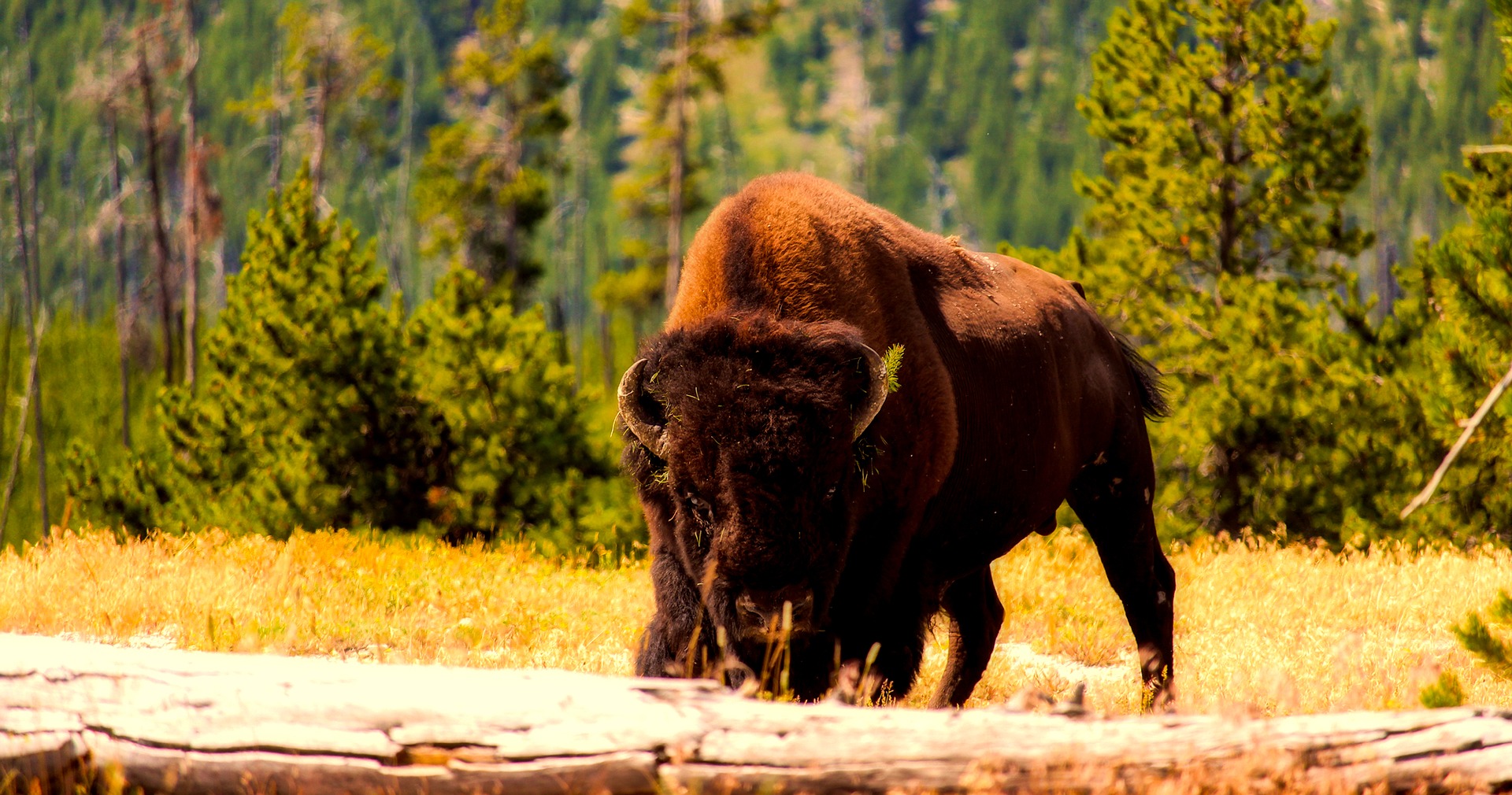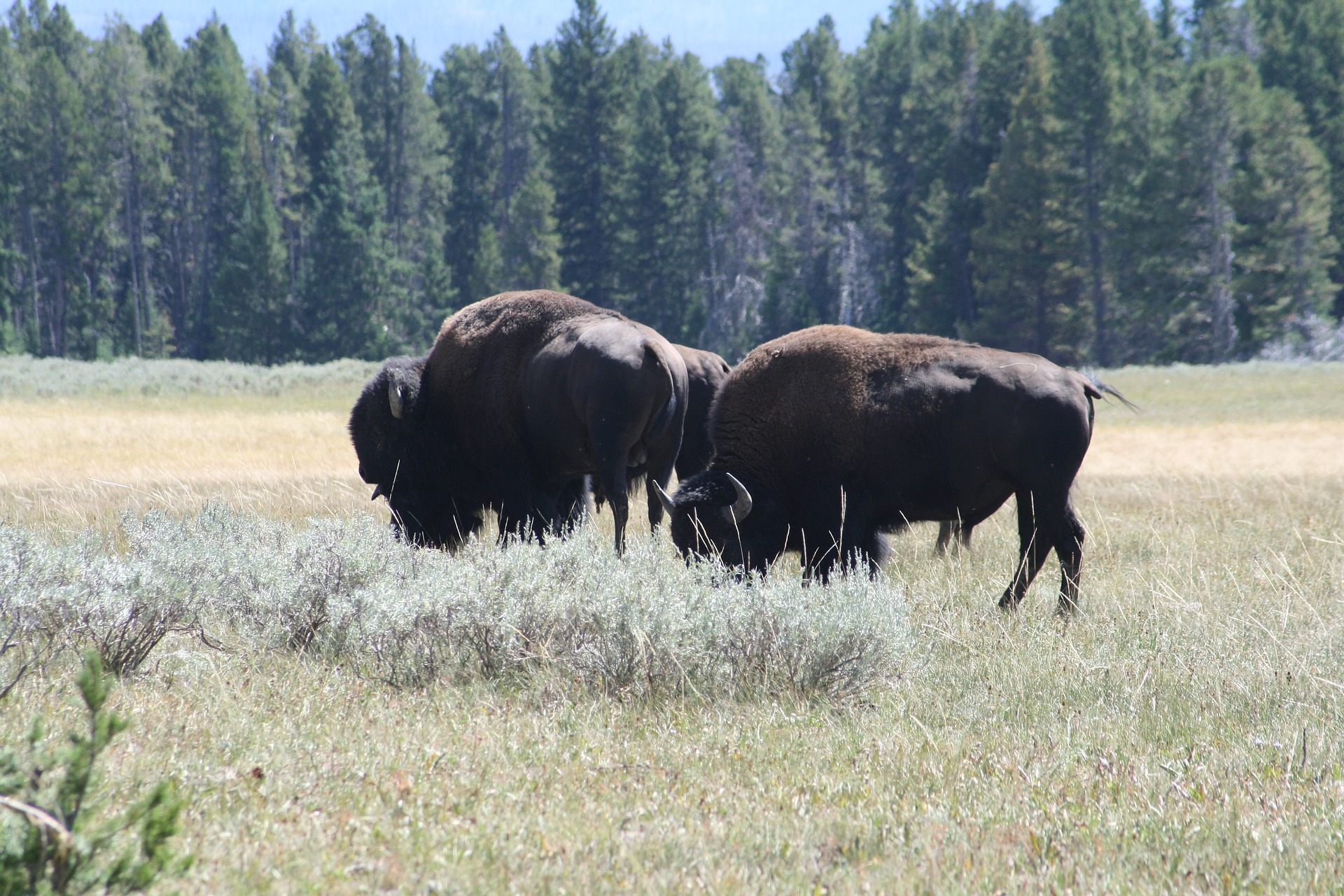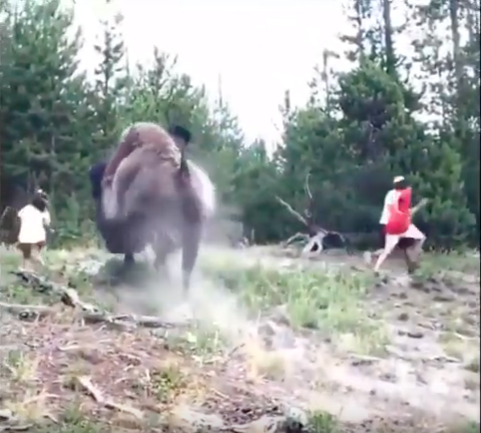Recently in the news, there was some video footage captured of a bison bull tossing a nine-year-old child into the air at Yellowstone National Park. She sustained some injuries according to some of the news reports but otherwise is physically fine. Mentally though, I wouldn’t doubt that she’s still very shaken up from the encounter.
What went wrong, though, and why? Could this have been prevented, and if so, how? What lessons can we all learn from this?
While I certainly wasn’t present at when and where that video was taken to see fully what actually happened, the short 13-second video clip still tells me a lot; probably a lot more than most people.
Let me first say that I personally don’t find this incident funny one bit. This is very serious stuff. That bison bull could’ve not just tossed her up in the air like a rag doll, but also then kept coming after her with the intent to do a lot of harm. I should be glad that the bull just gave her a hard lesson to learn and moved on with his life.
But I’m not glad that this even happened to begin with.
I will admit I have never been to Yellowstone National Park before. But I have known of many reports, both official and anecdotal of people getting far, far too close to wildlife, and doing some pretty stupid things around and even with wildlife.
There have also been numerous deaths in the park. Since YNP officially opened back in c. 1890, there has been over 300 deaths (and counting) reported that were a result of hot springs, wildlife encounters, geysers, falling off cliffs, poisonous gas, and poisonous plants. There’s even a couple of books written about the deaths in Yellowstone: See Lee Whittlesey’s book called Death in Yellowstone: Accidents and Foolhardiness in the First National Park, 2nd ed. (2014) and the book by the same name as the First Edition (1995).
Thankfully, there was no death involved in this incidence.
So what actually went wrong? Let’s break that video down (see link in the intro above) to find out.
When Bison Attack

Bison (Bison bison) are the largest native bovines in North America. They’re the second-largest in the taxonomic family Bovidae, a very close second behind the domesticated bovine (Bos primigenius taurus), the latter which has increased in size over the last several decades due to artificial selection.
Bison, as ruminant grazing herbivores, are naturally fairly peaceful creatures. They keep to themselves, waging battles primarily during the mating season as bulls compete for mating rights with their harems of cows. But when they are disturbed by hungry predators, their guard is up, and they’re ready to turn and fight or run like hell to escape danger.
When it comes to people, for the bison typically it’s a mutual agreement of, “if you leave me in peace, I’ll leave you in peace.” Most of the time, though, that agreement is constantly being breached by none other than people. Let’s not go back in time to when the First Nations hunted bison for food and sustenance because the human hunter is not much different from the wolf or bear who also hunts bison for food. I’m talking more about the dumb tourists who seem to always find unique ways of putting themselves in danger for whatever stupid excuse they come up with.
Regarding this recent incident, that mutual agreement was clearly breached by that girl.
We can see in the first second that he was grazing. Then, from 0:02 to 0:06 he stopped and slowly lumbered forward. But then there’s something very, very noticeable that I caught from 0:06 to 0:08 before he launched the attack. And let me tell you, very few people would’ve noticed this too. It’s actually a little harder to catch from the angle that the person holding her camera was from, which was basically from the front point of that bull’s shoulder.
What I noticed, though, was a subtle, yet really obvious stooping of the head and arching of the neck by the bull. To the average viewer, it certainly does look like he just bent down to sniff something on the ground.
Not only that, but he was also presenting himself by showing off his side in the direction of the girl, displaying just how big, intimidating, and powerful he is. That was his warning. He was saying, “I’m bigger and more powerful than you. Stay away, don’t come nearer, otherwise you will regret it!” It was just a mere fleeting two seconds where he gave that warning. Two seconds. That’s it. And then he went after her, dust flying off his back, his broad hump shaking with his powerful strides up that hill.
That behaviour from that bison is no different from what I’ve seen (and experienced first-hand) from domestic bovine bulls. Bison and cattle speak pretty well the same language. The thing with bison, though, is that they prefer to make things happen much quicker than a domestic bovine usually tends to (though there are exceptions). Especially a bison that is truly a wild animal, and is “old hands” at having to respond and act accordingly to their predatory enemies, like grizzly bears and timber wolves.
So, what about the girl? What was she doing out of frame? Was she just walking along behind the two people that suddenly ran away when the bull charged or was she attempting to approach this big beast? Or, did she do her due diligence to stay on the trail, but stopped and stared at him? I don’t know, the truth lies with her and the people that witnessed the whole event.
Simply stopping to stare at him, looking at him directly in the eyes, would be enough to elicit a charge. Approaching him while staring at him (or just approaching him) can also encourage an attack. (Studying the video footage more closely convinced me that she didn’t approach the bull at all.) Either way, both are direct challenges to that bull. And either actions are going to get you a bison bull (or cow) blowing snot down your back pockets and tossing you around like a rag doll.
I can’t blame the girl for not knowing the warning signs, let alone knowing that she should never stare directly at a bison. I don’t blame her, as a person, at all. What I blame above everything is how urbanization has desensitized and disconnected many, many people–like this poor girl–from the realities of the natural world.
This Could Have Been Prevented. But How?
 This whole incidence that certainly caught a lot of media attention really could have been prevented. All that girl had to do was keep her eyes averted from the bull, and to keep moving. She was way too close to that bull anyway–actually, most of the people walking along that trail were much too close, even the person who captured the video–and the poor girl just made things worse for herself by just stopping and staring.
This whole incidence that certainly caught a lot of media attention really could have been prevented. All that girl had to do was keep her eyes averted from the bull, and to keep moving. She was way too close to that bull anyway–actually, most of the people walking along that trail were much too close, even the person who captured the video–and the poor girl just made things worse for herself by just stopping and staring.
The problem with this single event, though, is that this is not the first time something like this has happened. There have been numerous other encounters with wildlife that were either close calls, lucky breaks, or dumb judgment calls that landed someone in the hospital or in the grave. I wouldn’t be surprised if most of them were preventable. I also wouldn’t be surprised if most of these crossing-of-paths were borne of a real deep disconnect to the realities of how dangerous and life-threatening the natural world can really be.
I realize that the people who work in the park do everything they can to help people be aware of how dangerous wildlife can be. They hand out pamphlets to everyone who comes through the park gate. They have park rangers on duty all the time watching for tourists doing stupid things with the animals. There’s a couple of books written on the “unnatural” deaths of people who visit Yellowstone. There are umpteen different pages, videos, articles, and websites that people can read about the dangers of visiting the first national park. News media outlets are great at picking up stuff as well, just like this incidence.
It all just doesn’t seem to be enough, though. As Einstein said (and I paraphrase here), human stupidity seems to be far more of an infinite thing than the Universe itself.
The only thing that really can help reduce casualties and make people more aware of the dangers of interacting with wild animals in a national park is a never-ending supply and effort to educate and inform as many people as possible, and then to encourage those people to spread the message and self-police themselves around the animals. That’s just an idea.
The thing is, Yellowstone (among many other national parks) really needs to stop being treated like another Disneyland resort retreat. It’s anything but that. It’s rather a sign of disrespect to the very essence that Yellowstone is made of. And there’s a lot of things that make up Yellowstone that we can all learn from.
Yellowstone Has Much to Teach Us About Ourselves, and Itself…
Two key things we all can learn from this incidence in itself
- Bison are big, dangerous, wild animals. They deserve to be respected as such, and not treated any differently.
- You will get charged if you stop and start a staring contest with a bison bull that’s much less than 25 yards away.
Above all, Yellowstone is a dangerous place to be in, let alone visit. It’s the very definition of wilderness. It’s not wilderness if there are places or creatures that are out there to kill you if you get caught off guard. Not only has the wilderness claimed the lives of people who are city born-and-raised, but it has also claimed the lives of those who call it home.
What actually makes Yellowstone seem even more dangerous, though, has much to do with the tourists themselves. I have no citations to back my own guesstimate up, but I would assume that 98% of the people who visit the park–and I’d say this is true for most all wilderness areas preserved under park status–come with these very naive misconceptions and preconceived notions as part of their urbanized conditioning that Yellowstone National Park is somehow just one giant petting zoo and manicured to the equivalency of a well-kept city park.
The fact that most of these people absolutely do not know what they don’t know, and have a very Disney-fied view of what “wilderness” and “nature” is, they are far more of a danger to themselves than anything else. The reactions from wildlife in various incidences such as this act as mirrors to show just how disconnected from nature people really are.
That’s perhaps the most significant lesson we can all afford to learn from this incidence.
More people are going to get hurt or killed if they continue this complacency and blatant ignorance, not to mention complete disrespect for these wild animals and the natural world.
The reality is that Yellowstone National Park was created to preserve a small part of a country’s nature and history. Nature isn’t some holiday resort, even though it was set aside for the average person to escape the hustle and bustle of everyday life to go “experience the great outdoors.” It still deserves the respect, admiration, and reservation for its dangerous beauty that it so strongly deserves.
So folks, make sure you read those pamphlets and take your selfies at a safe distance from the animals. Nobody, not even me, wants to read the next news report that you ended up in the hospital because you tried to pet a wild bison or heaven forbid, a bear.
